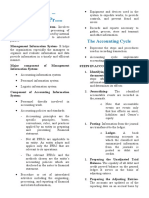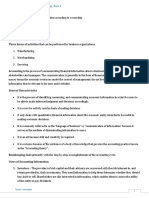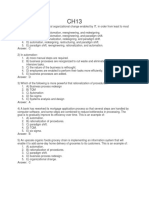0 ratings0% found this document useful (0 votes)
30 viewsSystems": General Ledger Systems Should
Systems": General Ledger Systems Should
Uploaded by
Karen Cael1. XBRL is an Internet standard designed for business reporting and information exchange that allows for the publication, exchange, and processing of financial and business information.
2. Management reporting systems provide information to support management decision making at different levels of the organization, from strategic to operational. They use responsibility accounting to assign accountability for economic events and resource usage.
3. Effective management reporting considers factors like formalization of tasks, responsibility and authority, span of control, and management by exception, as well as behavioral factors like goal congruence and information overload.
Copyright:
© All Rights Reserved
Available Formats
Download as DOCX, PDF, TXT or read online from Scribd
Systems": General Ledger Systems Should
Systems": General Ledger Systems Should
Uploaded by
Karen Cael0 ratings0% found this document useful (0 votes)
30 views2 pages1. XBRL is an Internet standard designed for business reporting and information exchange that allows for the publication, exchange, and processing of financial and business information.
2. Management reporting systems provide information to support management decision making at different levels of the organization, from strategic to operational. They use responsibility accounting to assign accountability for economic events and resource usage.
3. Effective management reporting considers factors like formalization of tasks, responsibility and authority, span of control, and management by exception, as well as behavioral factors like goal congruence and information overload.
Original Title
CHAPTER 8
Copyright
© © All Rights Reserved
Available Formats
DOCX, PDF, TXT or read online from Scribd
Share this document
Did you find this document useful?
Is this content inappropriate?
1. XBRL is an Internet standard designed for business reporting and information exchange that allows for the publication, exchange, and processing of financial and business information.
2. Management reporting systems provide information to support management decision making at different levels of the organization, from strategic to operational. They use responsibility accounting to assign accountability for economic events and resource usage.
3. Effective management reporting considers factors like formalization of tasks, responsibility and authority, span of control, and management by exception, as well as behavioral factors like goal congruence and information overload.
Copyright:
© All Rights Reserved
Available Formats
Download as DOCX, PDF, TXT or read online from Scribd
Download as docx, pdf, or txt
0 ratings0% found this document useful (0 votes)
30 views2 pagesSystems": General Ledger Systems Should
Systems": General Ledger Systems Should
Uploaded by
Karen Cael1. XBRL is an Internet standard designed for business reporting and information exchange that allows for the publication, exchange, and processing of financial and business information.
2. Management reporting systems provide information to support management decision making at different levels of the organization, from strategic to operational. They use responsibility accounting to assign accountability for economic events and resource usage.
3. Effective management reporting considers factors like formalization of tasks, responsibility and authority, span of control, and management by exception, as well as behavioral factors like goal congruence and information overload.
Copyright:
© All Rights Reserved
Available Formats
Download as DOCX, PDF, TXT or read online from Scribd
Download as docx, pdf, or txt
You are on page 1of 2
CHAPTER 8 XBRL — REENGINEERING FINANCIAL
“Financial Reporting and Management Reporting REPORTING
Systems” - the Internet standard specifically designed for
business reporting and information exchange
INFORMATION SYSTEM FUNCTIONS OF GLS - its objective is to facilitate the publication,
exchange, and processing of financial and business
General Ledger systems should: info
- collect accurate info
- classify and code data and accounts XML (eXtensible Markup Language)
- validate collected transaction/maintain accounting - metalanguage for describing markup languages
controls
- process transaction data POTENTIAL RISKS TO THE FRS
- store transaction data 1. A defective audit trail.
- generate timely financial reports 2. Unauthorized access to the general ledger.
3. GL accounts that are out of balance with subsidiary
GLS Database contains: accounts.
1. General ledger master file - based on the COA 4. Incorrect GL account balances because of
2. General ledger history file - for comparative unauthorized or incorrect journal vouchers.
financial support
3. Journal Voucher File - total collection of the XBRL TAXONOMY - specifies the data to be
journal vouchers processed in the current period. included in an exchange or report
4. Journal Voucher History File - contains journal Taxonomy - classification schemes that are
vouchers for past periods. This historical information compliant with XBRL specifications to accomplish a
supports management’s stewardship responsibility to specific information exchange or reporting objective
account for resource utilization such as filing with the SEC
5. Responsibility Center File - shows the revenues,
expenditures, and other resource utilization data for AREAS OF SPECIFIC CONCERN OF XBRL
each responsibility center in the organization 1. Taxonomy Creation
6. Budget Master File - contains budgeted amounts 2. Taxonomy Mapping Error
for revenues, expenditures, and other resources for 3. Validation of Instance Documents
responsibility centers
MANAGEMENT REPORTING SYSTEM
THE FINANCIAL REPORTING SYSTEM - often called discretionary reporting
- way to meet an entity’s reporting obligation
- primary recipients of financial statement Factors that Influence the MRS
information are external users, such as stockholders, 1. Formalization of Tasks - management should
creditors, and government agencies structure the firm around the tasks it performs rather
than around individuals with unique skills
Financial Reporting Procedures 2. Responsibility and Authority
1. Capture the transaction * Responsibility - an individual’s obligation to
2. Record in special journal achieve desired results
3. Post to subsidiary ledger 3. Span of Control - refers to the number of
4. Post to general ledger subordinates directly under his or her control
5. Prepare the unadjusted trial balance 4. Management by Exception - suggests that
6. Make adjusting entries managers should limit their attention to potential
7. Journalize and post adjusting entries problem areas rather than being involved with every
8. Prepare the adjusted trial balance activity or decision
9. Prepare the financial statements
10. Journalize and post the closing entries MANAGEMENT FUNCTION, LEVEL, AND
11. Prepare the post-closing trial balance DECISION TYPE
1. Strategic Planning Decisions (Top Management)
- have long-term time frames
- require highly summarized information - every economic event that affects the organization
- tend to be nonrecurring is the responsibility of and can be traced to an
- high degree of uncertainty individual manager
- broad in scope and have a profound impact on the
firm BEHAVIORAL CONSIDERATIONS
1. Goal Congruence
2. Tactical Planning Decisions (Middle Management) 2. Information Overload - occurs when a manager
- decisions are shorter term, more specific, recurring, receives more information than he or she can
have more certain outcomes, and have a lesser impact assimilate
on the firm than strategic decisions 3. Inappropriate Performance Measures - when
inappropriate performance measures are used, that
3. Management Control Decisions (Middle one purpose of a report to stimulate behavior
Management) consistent with the objectives of the firm can have the
- involves motivating managers in all functional opposite effect
areas to use resources, including materials, personnel,
and financial assets, as productively as possible
4. Operational Control Decisions (Operations
Management)
- narrower and more focused than tactical decisions
because they are concerned with the routine tasks of
operations
* Three Basic Elements
a. Setting standards - Standards are pre-established
levels of performance that managers believe are
attainable
b. Evaluating performance - looking for variance
c. Taking corrective action
TYPES OF MANAGEMENT REPORTS
1. Programmed Reporting - provide information to
solve problems that users have anticipated
a. Scheduled reports - reports according to time
frame; regular reports
b. On-demand reports - triggered by events, not by
the passage of time
2. Ad Hoc Reporting - Managers with limited
computer background can quickly produce ad hoc
reports from a terminal or PC, without the assistance
of data processing professionals.
Data mining - process of selecting, exploring, and
modeling large amounts of data to uncover
relationships and global patterns that exist in large
databases but are hidden among the vast amount of
fact
Verification model - uses a drill-down technique to
either verify or reject a user’s hypothesis
RESPONSIBILITY ACCOUNTING
You might also like
- Managing People in An Organisation FarmboxDocument11 pagesManaging People in An Organisation FarmboxMaira Hashmi67% (6)
- Mas ReviewerDocument10 pagesMas ReviewerKathrine Nicole FernanNo ratings yet
- Resa MAS-01: Management Accounting - Financial Management: - T R S ADocument4 pagesResa MAS-01: Management Accounting - Financial Management: - T R S AKenneth Pimentel100% (1)
- Sephora Group-5Document20 pagesSephora Group-5api-241807815100% (2)
- AIS - Written ReportDocument10 pagesAIS - Written ReportMohammad Nowaiser MaruhomNo ratings yet
- Financial Reporting and Management Reporting Systems ReviewerDocument7 pagesFinancial Reporting and Management Reporting Systems ReviewerSohfia Jesse Vergara100% (1)
- Financial Reporting and Management Reporting SystemsDocument40 pagesFinancial Reporting and Management Reporting SystemsLive LoveNo ratings yet
- Management Accounting Basic ConceptsDocument5 pagesManagement Accounting Basic ConceptsAlexandra Nicole IsaacNo ratings yet
- Financial Reporting and Management Reporting Systems: Review QuestionsDocument11 pagesFinancial Reporting and Management Reporting Systems: Review QuestionsclaraNo ratings yet
- SM-08-new QQQQDocument41 pagesSM-08-new QQQQpsbacloud100% (1)
- AIS Chap 8 NotesDocument7 pagesAIS Chap 8 NotesKrisshaNo ratings yet
- UST Management Accounting Basic ConceptsDocument5 pagesUST Management Accounting Basic ConceptsNaddieNo ratings yet
- CHAPTER 1 - Management AccountingDocument12 pagesCHAPTER 1 - Management AccountingMaria Elliane Querubin RosalesNo ratings yet
- AIS ReviewerDocument5 pagesAIS ReviewerAngel Joy HelicameNo ratings yet
- SM - Hall 10e - CH 8Document39 pagesSM - Hall 10e - CH 8Shangshang Thea100% (1)
- Chapter 8Document6 pagesChapter 8John PaulNo ratings yet
- AIS NotesDocument9 pagesAIS Notesbartabatoes rerunNo ratings yet
- Financial AccountingDocument3 pagesFinancial AccountingJaimee CruzNo ratings yet
- Nadiatul - HW Week 7Document4 pagesNadiatul - HW Week 7nadxco 1711No ratings yet
- The Nature and Purpose of Management Accounting: 1.1 Acca Syllabus Guide Outcome 1Document366 pagesThe Nature and Purpose of Management Accounting: 1.1 Acca Syllabus Guide Outcome 1Şâh Šůmiť100% (1)
- MAS A - Management AccountingDocument4 pagesMAS A - Management AccountingIvan ChiuNo ratings yet
- Acowtancy F2 PDFDocument369 pagesAcowtancy F2 PDFŞâh ŠůmiťNo ratings yet
- Accounting 202Document8 pagesAccounting 202Gortex MeNo ratings yet
- Far NotesDocument4 pagesFar NotesMikasa AckermanNo ratings yet
- 1.1 Intro To SCM and Management AccountingDocument6 pages1.1 Intro To SCM and Management AccountingXyril MañagoNo ratings yet
- The Accounting ProcessDocument4 pagesThe Accounting ProcessPrincess Norjannah KhalidNo ratings yet
- 1.2 Financial and Management AccountingDocument55 pages1.2 Financial and Management Accountingteshome100% (2)
- ACCA F2 Course NotesDocument494 pagesACCA F2 Course NotesТурал Мансумов100% (5)
- MA CH 1Document18 pagesMA CH 1prasad guthiNo ratings yet
- Accounting Midterms ReviwerDocument5 pagesAccounting Midterms Reviwermary josefaNo ratings yet
- Accounting Midterms ReviwerDocument5 pagesAccounting Midterms ReviwermariaNo ratings yet
- Updates in Managerial AccountingDocument32 pagesUpdates in Managerial Accountingstudentone100% (3)
- CH 01Document6 pagesCH 01Kanbiro OrkaidoNo ratings yet
- Fa (Mubs) Mba 2018-19Document185 pagesFa (Mubs) Mba 2018-19henrywasulaNo ratings yet
- Chapter 1 - Accounting PRDocument21 pagesChapter 1 - Accounting PRJohn Michael SorianoNo ratings yet
- Week 2 - Lesson 2 The Accounting ProcessDocument16 pagesWeek 2 - Lesson 2 The Accounting ProcessRose RaboNo ratings yet
- Strategic Cost ManagementDocument5 pagesStrategic Cost ManagementJaeNo ratings yet
- Intermediate Accounting 1aDocument13 pagesIntermediate Accounting 1aMarked BrassNo ratings yet
- Chapter 6 BTFDocument4 pagesChapter 6 BTFlamuyen17092003No ratings yet
- Financial Management NotesDocument4 pagesFinancial Management NotesWakin PoloNo ratings yet
- Accounting Information System ReviewerDocument17 pagesAccounting Information System ReviewerAcain Rolien100% (1)
- Strategic Cost Management - CompressDocument18 pagesStrategic Cost Management - CompressDannis Anne RegajalNo ratings yet
- SCOSMAN 1. Introduction To Management Accounting Strategic MGT ModuleDocument10 pagesSCOSMAN 1. Introduction To Management Accounting Strategic MGT ModuleJoneric RamosNo ratings yet
- Syllabus 2.0 Outline Conceptual FrameworkDocument6 pagesSyllabus 2.0 Outline Conceptual FrameworkRey Organiza ContaNo ratings yet
- MA1 - A - Management AccountingDocument3 pagesMA1 - A - Management AccountingJoshua UmaliNo ratings yet
- AIS Reviewer Quiz 1Document5 pagesAIS Reviewer Quiz 1Airon NazalNo ratings yet
- Chapter 1 - Introduction To Cost & Management AccountingDocument30 pagesChapter 1 - Introduction To Cost & Management AccountingJiajia Mox100% (1)
- Study Notes For Chapter 1 - MAS 1Document4 pagesStudy Notes For Chapter 1 - MAS 1InserahNo ratings yet
- Strategic Cost Management - Management AccountingDocument5 pagesStrategic Cost Management - Management AccountingVanna AsensiNo ratings yet
- Intensive Basic AccountingDocument4 pagesIntensive Basic AccountingMaryll Cyan Magnaye100% (2)
- Answers AccountingDocument3 pagesAnswers AccountingAriane Jill HipolitoNo ratings yet
- AuditDocument79 pagesAuditNikunj D PatelNo ratings yet
- AIS Chapter 2 SummaryDocument11 pagesAIS Chapter 2 SummaryKiana FernandezNo ratings yet
- Auditing Theory Cabrera 2010 Chap 2Document8 pagesAuditing Theory Cabrera 2010 Chap 2Squishy potatoNo ratings yet
- General LedgerDocument1 pageGeneral LedgerKlay InfantesNo ratings yet
- Basic Framework of Management AccountingDocument18 pagesBasic Framework of Management AccountingCathleen TenaNo ratings yet
- CHAPTER 1 - Introduction To Cost AccountingDocument18 pagesCHAPTER 1 - Introduction To Cost AccountingDecery BardenasNo ratings yet
- Managerial Accounting - MHRM 515Document151 pagesManagerial Accounting - MHRM 515Titima Nyum100% (1)
- Basic ConceptsDocument5 pagesBasic ConceptsAgatha ApolinarioNo ratings yet
- Chapter 6 Financial Reporting and Management Reporting System 10.2021Document15 pagesChapter 6 Financial Reporting and Management Reporting System 10.2021AMNo ratings yet
- "The Language of Business: How Accounting Tells Your Story" "A Comprehensive Guide to Understanding, Interpreting, and Leveraging Financial Statements for Personal and Professional Success"From Everand"The Language of Business: How Accounting Tells Your Story" "A Comprehensive Guide to Understanding, Interpreting, and Leveraging Financial Statements for Personal and Professional Success"No ratings yet
- CIO Best Practices: Enabling Strategic Value with Information TechnologyFrom EverandCIO Best Practices: Enabling Strategic Value with Information TechnologyRating: 4 out of 5 stars4/5 (1)
- Intermediate Accounting Test Bank 3Rd Edition - Test Bank Intermediate Accounting Test Bank 3Rd Edition - Test BankDocument39 pagesIntermediate Accounting Test Bank 3Rd Edition - Test Bank Intermediate Accounting Test Bank 3Rd Edition - Test BankKaren CaelNo ratings yet
- Notes - Quantitative TechniquesDocument50 pagesNotes - Quantitative TechniquesKaren CaelNo ratings yet
- Test Bank With Answers Intermediate Accounting 12e by Kieso Chapter 17 Test Bank With Answers Intermediate Accounting 12e by Kieso Chapter 17Document38 pagesTest Bank With Answers Intermediate Accounting 12e by Kieso Chapter 17 Test Bank With Answers Intermediate Accounting 12e by Kieso Chapter 17Karen CaelNo ratings yet
- Cael, Michelle Karen Joy - PreTest - Chapter 12Document1 pageCael, Michelle Karen Joy - PreTest - Chapter 12Karen CaelNo ratings yet
- Chapter 6 Activity Based CostingDocument1 pageChapter 6 Activity Based CostingKaren Cael100% (1)
- Chapter 3 Material Procurement, Use and ControlDocument3 pagesChapter 3 Material Procurement, Use and ControlKaren CaelNo ratings yet
- Chapter 5 Accounting For Factory OverheadDocument2 pagesChapter 5 Accounting For Factory OverheadKaren CaelNo ratings yet
- Cael, Michelle Karen Joy - Pre-Test Introduction To Business TaxesDocument1 pageCael, Michelle Karen Joy - Pre-Test Introduction To Business TaxesKaren CaelNo ratings yet
- Chapter 2Document2 pagesChapter 2Karen CaelNo ratings yet
- Chapter 3Document2 pagesChapter 3Karen CaelNo ratings yet
- "The Conversion Cycle": Two Subsystems: - Ends With Completed Product Sent To The Finished Goods WarehouseDocument2 pages"The Conversion Cycle": Two Subsystems: - Ends With Completed Product Sent To The Finished Goods WarehouseKaren CaelNo ratings yet
- Introduction and Preface To PFRSsDocument4 pagesIntroduction and Preface To PFRSsKaren CaelNo ratings yet
- Potential Risk TreatmentDocument3 pagesPotential Risk TreatmentKaren CaelNo ratings yet
- Excise Taxes NotesDocument26 pagesExcise Taxes NotesKaren Cael100% (1)
- Logic Chapter 2 - LectureDocument3 pagesLogic Chapter 2 - LectureKaren CaelNo ratings yet
- Chapter 4Document1 pageChapter 4Karen CaelNo ratings yet
- Introduction To Transaction ProcessingDocument2 pagesIntroduction To Transaction ProcessingKaren CaelNo ratings yet
- Customer Satisfaction Towards Service Provided by HDFC Bank in DombivliDocument102 pagesCustomer Satisfaction Towards Service Provided by HDFC Bank in DombivliMukesh chavan 29No ratings yet
- 5 MBA Freshers Resume Samples, Examples - Download Now! PDFDocument7 pages5 MBA Freshers Resume Samples, Examples - Download Now! PDFPiyushKumarNo ratings yet
- JDE Manufacturing Module TrainingDocument54 pagesJDE Manufacturing Module Trainingabhi00No ratings yet
- BP TQM Fraginal Mendoza VillanuevaDocument26 pagesBP TQM Fraginal Mendoza VillanuevaMa. Liza FitalcoNo ratings yet
- What Is A Distribution ChannelDocument2 pagesWhat Is A Distribution ChannelBlueberry TartNo ratings yet
- Personal Statement: Christine DaileyDocument2 pagesPersonal Statement: Christine DaileyRania NourNo ratings yet
- ISO 14000 AuditDocument3 pagesISO 14000 Auditjohnthep20090% (1)
- Till CE REDocument80 pagesTill CE REMMNKNo ratings yet
- Depreciation Policy of Mahindra and MahindraDocument8 pagesDepreciation Policy of Mahindra and MahindranidhibhopalNo ratings yet
- 6806 - Operating Segment and Interim ReportingDocument2 pages6806 - Operating Segment and Interim ReportinglllllNo ratings yet
- Discussion Questions 2Document2 pagesDiscussion Questions 2Paulo MNo ratings yet
- Cash Runway Forecast: Click HereDocument3 pagesCash Runway Forecast: Click HereRyan YoungrenNo ratings yet
- Grade 9 EMS Final Examination 2023Document5 pagesGrade 9 EMS Final Examination 2023s.ngiba01100% (1)
- 10 1108 - Jbsed 02 2021 0017Document19 pages10 1108 - Jbsed 02 2021 0017lisarurariaNo ratings yet
- Profile of The CompanyDocument30 pagesProfile of The CompanyChirag MunirajuNo ratings yet
- Essential of Marketing and Custormer ServiceDocument14 pagesEssential of Marketing and Custormer Servicejohn mwangi100% (1)
- CH 13Document13 pagesCH 13nishilNo ratings yet
- AF2111 Subject Outline 201617 S2Document12 pagesAF2111 Subject Outline 201617 S2kaishing sinNo ratings yet
- Tutorial Letter 201/1/2020: Financial Accounting Principles For Law PractitionersDocument6 pagesTutorial Letter 201/1/2020: Financial Accounting Principles For Law Practitionersall green associates100% (1)
- Gypsum Plaster Board: WWW - Entrepreneurindia.coDocument83 pagesGypsum Plaster Board: WWW - Entrepreneurindia.cobikash_88No ratings yet
- Jared Resume FinalDocument2 pagesJared Resume FinalJared WilburnNo ratings yet
- DFSS Green Belt - Smallpeice EnterprisesDocument1 pageDFSS Green Belt - Smallpeice EnterprisesManas deep singhNo ratings yet
- Form of Unconditional Bank Guarantee ("Performance Bank Guarantee")Document2 pagesForm of Unconditional Bank Guarantee ("Performance Bank Guarantee")9novtarunNo ratings yet
- Coca Cola CaseDocument4 pagesCoca Cola CaseCarlos HerreraNo ratings yet
- Basics - EWMDocument23 pagesBasics - EWMRajeev Jindal100% (1)
- U/W: Investing To Fortify BTM Growth: Polynovo (PNV)Document7 pagesU/W: Investing To Fortify BTM Growth: Polynovo (PNV)Muhammad ImranNo ratings yet
- Comparison of Variation ClausesDocument11 pagesComparison of Variation ClausesZinck Hansen100% (1)
- Tanishq JRM 090729172938 Phpapp01Document25 pagesTanishq JRM 090729172938 Phpapp01Pragya AgrawalNo ratings yet










































































































